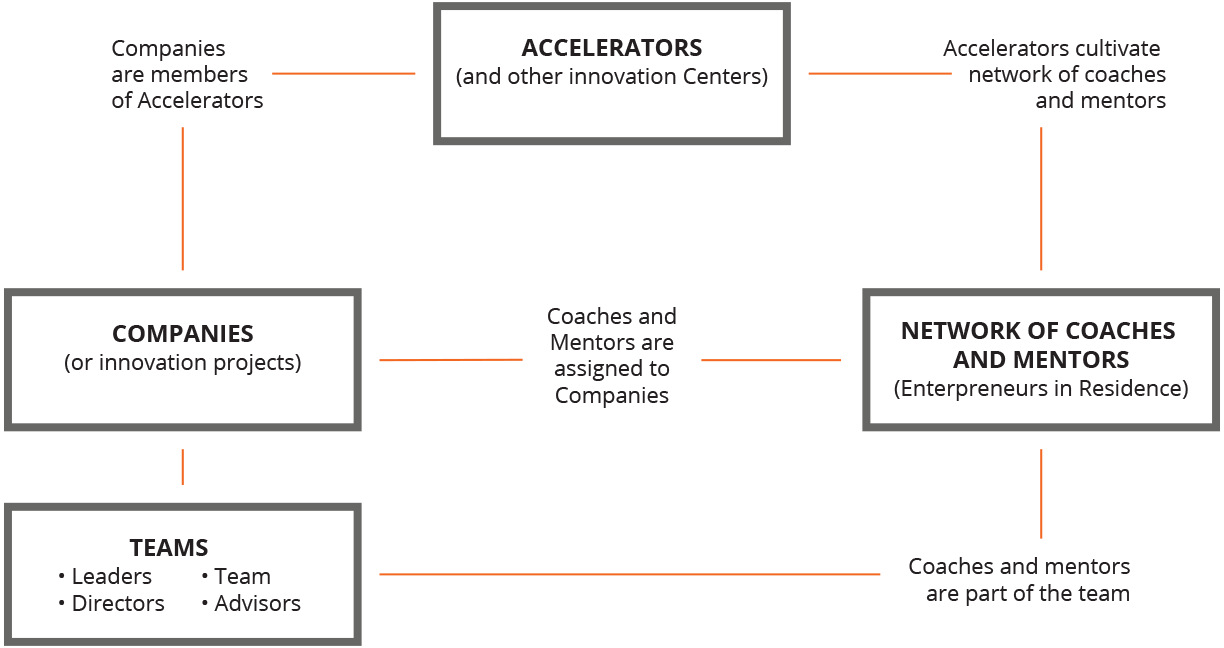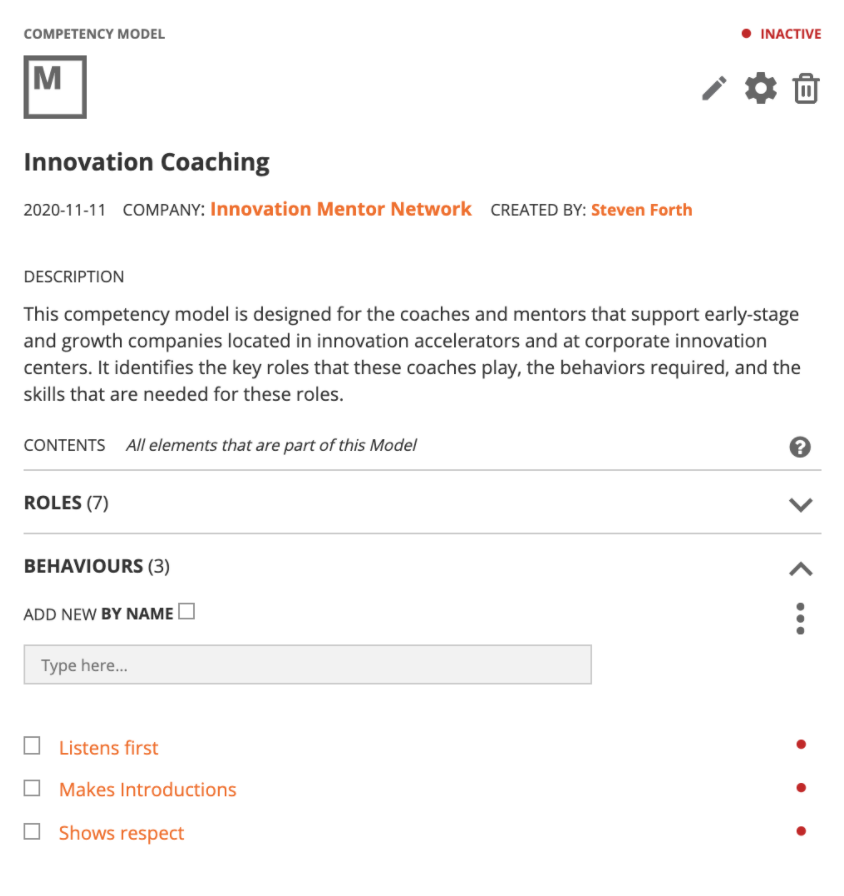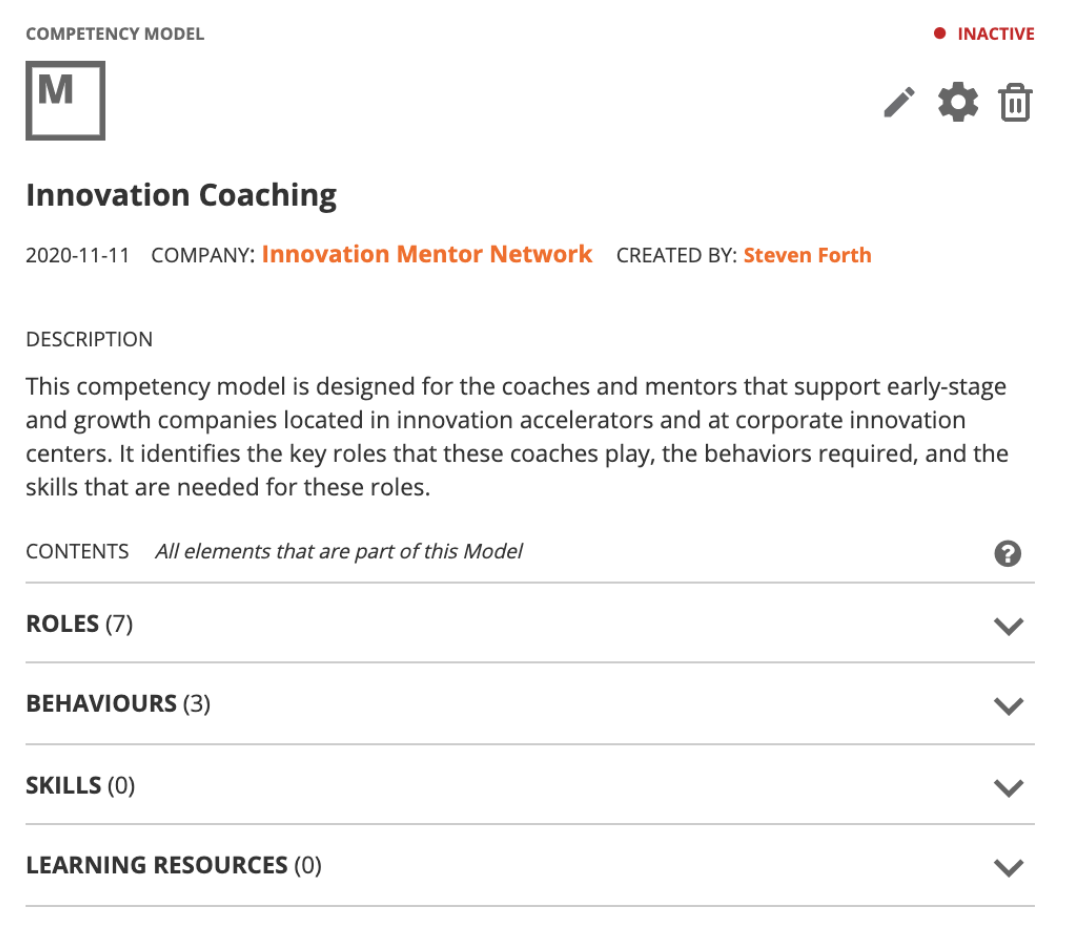Designing a Competency Model for Innovation Coaches
Steven Forth is co-founder and managing partner at Ibbaka. See his skill profile here.
“Innovation happens when new skills and ideas are paired with wisdom (skills nurtured over many years) —and that is what accelerators do”
Chuck Hamilton
In this post we give a practical example of how we developed a small competency model. The model is for Innovation Coaching. It will be of interest to everyone responsible for designing and managing competency models, and for people with a specific interest in innovation and coaching. We begin with some context. All competency models require context to make them meaningful.
Ibbaka is working on an innovation mentoring network for the people who coach at innovation labs, accelerators, incubators and the like. This is a natural use of the Ibbaka Talent platform and Ibbaka itself was born in one of these accelerator programs, Venture Labs in Vancouver. We are being coached in this by Chuck Hamilton, one of the Entrepreneurs in Residence (EIRs) at Venture Labs.
You can see Chuck’s skill profile here.
Who is this competency model for?
As part of this work, we are designing a simple competency model for Innovation Coaching. This will be offered as one of our Open Competency Models, meaning that it will be available under a Creative Commons license and that it will be open to evolving and will grow to incorporate the skills of the most effective coaches.
Before we start the design of the model, we need to ask what value the innovation mentoring network is meant to bring to the four stakeholder groups and how the competency model contributes to this.
The four stakeholder groups are
The coaches and mentors
The companies being coached
The people at these companies
The innovation center and accelerators
For coaches and mentors
These are the people who provide critical guidance to early-stage and growth companies. Some are successful start-up executives, others have had senior roles at large companies and there are also consultants and researchers with the skills to help companies in different areas. One challenge is to match the coaches to the companies. In British Columbia, Innovate BC supports some of these people as Executives in Residence (EIRs).
For the companies
The companies are the clients of the incubators, accelerators and other innovation centers. In a corporate innovation center these could be the different innovation projects being funded. Companies need a way to dynamically update what they need in terms of support from incubators, ideally described in terms of the skills they are looking for, including domains of knowledge. This helps incubators and accelerators do a better job of helping these companies.
For the people at the companies
The skill profile of a company is really the skills of the people contributing to the company. This can go beyond employees to the extended talent network of investors, directors, advisors, contractors and even customers. (We will have more to say about the important role of customer skills in the future.)
For the innovation centers
The innovation centers are where all of the other stakeholders come together. Their main role is to provide a context for companies and their teams and advisors to interact in order to support growth. This is a critical factor in innovation and requires its own special skills. The Innovation Mentor Networks that use this competency model are centered on these innovation centers. There are multiple centers in most technology hubs and many corporations manage their own innovation centers.
(Ibbaka has designed its own pricing to support all of these different groups. You can llearn more about how we approach pricing here.)
What is the role of a competency model?
What role does the competency model play in this?
A competency model is a way to organize the relations between Jobs, Roles and Teams and the Competencies, Behaviors and Skills that are needed for performance. An individual can use a competency model to better understand the skills needed for a role. An organization can use the competency model as a lens, to look at the skills of an individual or group, and as a frame to organize and prioritize training and support.
Designing the Competency Model for Innovation Coaches
Part 1: The roles covered
Now that we understand who will be using the competency model, and how they will be using it, the first step is to focus in on the people and the roles they play. Coaching and mentoring early-stage and growth companies takes several different forms.
Conversations with the companies receiving the coaching, and with experienced coaches and mentors, helped us identify several different roles.
Leadership Coach
Product Coach
Technology Coach
Finance and Financing Coach
Go-to-Market Coach
Scaling Coach
Governance Coach
That is seven different roles, which is a lot. We generally prefer to keep the number of roles to five in introductory models, but let’s go with these seven. What can we say about each role?
Leadership
The Leadership Coach helps the executive team to grow and perform as leaders. A good leadership coach is a kind of servant leader who is concerned with helping the individuals at the company grow as leaders and as a leadership team.
Product
The Product Coach (or Offer Coach) helps the company get to product-market fit. As this is customer focussed, one could almost call this a ‘customer coach’ but it is a very special kind of customer coach, one whose job is to help product (or offer or service) leadership understand the fastest path to minimum viable product and then how to scale the offer. The Product coach helps the company to ‘build the right thing.’
Technology
Most innovation companies (and innovation product teams) are using some form of technology. Technology and architecture choices and development and testing practices have a profound impact on scaling and future success. The Technology coach helps make sure the company ‘builds the thing right.’
Finance and financing
Companies need financing to grow. Very few truly innovative companies can be bootstrapped (grow based on initial customer revenues) and financing of some form is generally needed. There is a well understood series of financing events that companies follow, but few founders and early-stage leadership teams have experience with this. Some companies will have governance board members that can play the role of Financing coach, others can leverage the services of a part-time CFO (Chief Financial Officer) but others will benefit from a financing coach who knows the different financing paths and how to walk down them.
Go-to-market
Early stage and growth companies generally combine marketing and sales into a go-to-market function. This is a complex process and finding the right coach is critical to success. The best products can fail without a good go-to-market strategy coupled with great execution (yes, the execution is even more important than the strategy).
Scaling
Once a company archives product-market fit and has initial success with go-to-market it needs to scale. Scaling requires a whole new set of skills. There are new processes to implement, financial controls need to be put in place, hiring often goes on at a frenetic pace. This all requires the advice of experienced people who have been there and know the risks.
Governance
The governance board is a key source of advice to the company. The board is chosen by the shareholders but in fact the company founders have a great deal of influence on who joins the board and building and interacting with the board is its own skillset. Learning how to make the best use of a board and how to work effectively with a board requires a specialized form of coaching.
Watch for an upcoming interview with Pieter Dorsman, one of the leaders in the Vancouver innovation community and a person with a great deal of experience in building effective boards.
Of course, the same person often plays more than one role. At many accelerators, each company is assigned just one coach or EIR, whose job includes bringing in people with other expertise, such as the design of pricing model, when needed.
Part 2: Behaviors, Skills and Learning Resources
What else should be part of this model? At Ibbaka our preference is to keep these models as simple as possible, and we considered keeping this one to just Roles and Skills. But conversations with experienced EIRs, coaches and company founders made it clear that Roles and Skills alone would not be enough.
The leaders of the accelerators are very concerned about the behaviors of the coaches. In a sense, it is the coaches who are the ‘brand ambassadors’ for the accelerators and they need to see some critical behaviors in coaches in order to be comfortable introducing them to their customers.
Examples of some of these behaviors are…
Listens first
Shows respect
Makes introductions
Many behaviors are relevant to all innovation coaching roles, but there can also be behaviors that are role specific.
At Ibbaka, we put skills at the centre of our competency models. They are the genes of performance. Skills may need other things to be expressed, the proper environment, a network of other skills to activate them, but they are what makes performance possible. Ibbaka always includes skills in its competency models, and it is skills that are the most powerful way to connect a role with a skill profile.
You can learn more about how skill profiles and competency models connect here.
Learning resources are another important part of a competency model. The innovation centers have access to many different resources. Most of these are directed towards the companies and their teams, but some are of interest to the coaches and mentors, either to help them develop their own skills or as resources they may want to provide to the companies they are supporting.
At this point, before adding concrete skills and learning resources, our model looks like this.
The model on the Ibbaka Talent Platform
You will have noticed that we are building this competency model in the Ibbaka Talent platform.
Why is this?
There are four main reasons for this.
The competency model is a living document. It evolves with use and is informed by the actual skills that coaches and mentors are using on the teams they are working with. A static document, whether in a spreadsheet or Powerpoint, or locked up in the database of an HRIS (Human Resources Information System), talent management system or learning management system rapidly becomes obsolete and people stop referring to it.
Competency models need to be linked to skill profiles. A competency model that is not connected to the skills of actual people is an academic exercise. Competency models come alive when people are using them to understand what skills they need and to find the learning and other resources they need to improve their performance.
Competency models are frequently customized. Most organizations have their own approach to innovation and coaching. An Open Competency Model like this one is meant to be a springboard from which organizations can develop their own models that reflect their own values and approach.
Competency models are integrated with other software platforms. Many different parts of the talent management ecosystem depend on skills and how they are organized into competency models.
Not ready to begin working directly on the Ibbaka Talent Platform? We do have a simple tool that you can use to get started designing your own competency model.
A project we are working on right now is to make it possible for badging and micro credentialing systems to connect to a competency model library and align a badge with one or more components of a competency model. We are doing this work with the CanCred Factory, more on that work coming soon.
Next steps
If you are interested in the Innovation Mentor Network, as a potential coach, a company at an innovation center or as an innovation accelerator, incubator or corporate innovation center, please contact us through info@ibbaka.com.
Ibbaka Posts on Competency Models and Competency Frameworks
From user experience to competency model design - Margherita Bacigalupo and EntreComp
Competency framework designers on competency framework design: The chunkers and the slice and dicers
Competency framework designers on competency framework design: Victoria Pazukha
Design research - How do people approach the design of skill and competency models?
The Skills for Career Mobility - Interview with Dennis Green
Lessons Learned Launching and Scaling Capability Management Programs
Designing a Competency Model for Innovation Coaches (this post)
Talent Transformation - A Conversation with Eric Shepherd, Martin Belton and Steven Forth
Individual - Team - Organizational use cases for skill and competency management
Co-creation of Competency Models for Customer Success and Pricing Excellence
Competencies for Adaptation to Climate Change – An Interview with Dr. Robin Cox
Architecting the Competencies for Adaptation to Climate Change Open Competency Model
Integrating Skills and Competencies in the Talent Management Ecosystem
Organizational values and competency models – survey results














